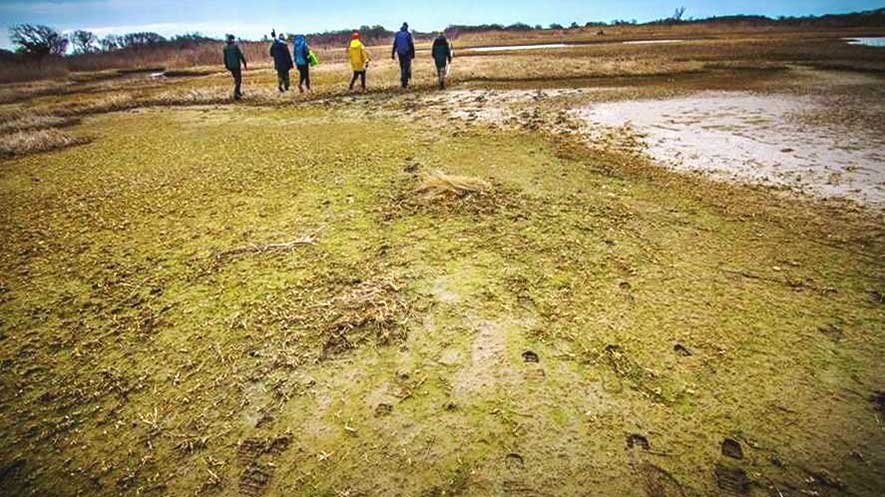Sea levels in Rhode Island have been rising at an increasing rate, particularly over the last 30 years.
Observations in many of Rhode Island’s salt marshes—including the marshes in Ninigret Pond—confirm the models: salt marshes are beginning to drown in place, converting to mud flats or open water. Why is this a problem? Salt marshes perform many important functions, including acting as a natural buffer to storms and providing protection for communities along our shorelines.
Within the Charlestown breachway in Ninigret Pond, sand has been accumulating as it is swept in by shoreline currents. As it enters the pond it covers eelgrass beds—an important habitat—and makes navigation difficult for the many boaters who enjoy the pond.
The Rhode Island Coastal Resources Management Council (CRMC) and its partners have designed a project that will use sediment dredged from the breachway channel to build up the elevation of the adjacent marsh. The goals of the project are to restore and enhance the functions of the existing salt marsh making it more resilient to future sea level rise, to slow the entry of sediment into the pond and to improve navigation by creating a deeper breachway channel.
The CRMC has contracted with JF Brennan Company Inc., an environmental services and marine construction firm that specializes in waterway remediation and habitat restoration to dredge two sedimentation basins within the breachway channel. Most of the material that is dredged will be discharged from pipes onto the marsh to the west of the channel. The discharged material will then be spread and graded to elevations that are appropriate for salt marsh plants. Some of the material dredged from the basins will be discharged along the shore, in the inter dal area to the east of the breachway. This will help to re- nourish the beach along the shoreline.
Since receiving a one-year extension in 2016, the Rhode Island Coastal Resources Management Council (CRMC) and its project partners have refined the project design, and soon will be going out to bid for construction.
Dredging will take place in the Charlestown breachway and the tidal delta at the entrance to the pond. The material will be beneficially reused on the beach and salt marsh. Construction is scheduled to begin mid-November 2016 and end in April 2017. Because the breachway and delta are very dynamic areas, the CRMC also utilized the extension timeframe to conduct an updated bathymetric survey of the project dredging area.
The total project area is approximately 25 acres.
The goal of the elevation enhancement in Ninigret is to increase the elevation of the marsh, where vegetation has died from increased flooding due to rising sea levels. Dredged sand will be added to the marsh surface, and will range in thickness up to 12 inches deep. Much of the marsh vegetation is expected to regrow naturally, but the CRMC is working with Save The Bay on a replanting strategy to enhance this process. The strategy will include using native marsh plants grown from seeds collected from the site by New England Wild Flower Society. The CRMC expects to replant approximately 3 acres of the project area next spring, with additional planting done in subsequent years as needed and as funds allow.
Immediately after the dredged material is spread and graded, the marsh will look much like a mud flat—a bare area of ex- posed sediment. Over me, salt marsh grasses will begin to recolonize the covered areas. Save The Bay will be working with CRMC to plant a portion of the restored area to “jump start” the natural recolonization process. Many of the plants to be planted will come from seeds collected here in Rhode Island with the help of the New England Wildflower Society. Over the next few years, it is anticipated that healthy salt marsh grasses will again cover the restored marsh. The breachway channel will be deepened significantly to create basins where sediment can accumulate overtime.
This will be the third salt marsh elevation enhancement project in Rhode Island and the second the CRMC has overseen: Narrow River was begun last season as a pilot for other projects and will continue this fall, and restoration at Sachuest Point in Middletown was started this winter by U.S. Fish & Wildlife Service.
Funding for these projects, including Ninigret, comes from Superstorm Sandy relief funds under the U.S. Department of the Interior. They’re part of a regional effort to restore coastal areas affected by Sandy. The grant monies for the Ninigret restoration project come directly from National Fish & Wildlife Foundation’s Hurricane Sandy Coastal Resilience Program. The State and the Towns of Charlestown and Westerly are contributing matching funds to the project.





